Samsung Q70C Reviewed at $799.00 (55")
Product Name: Samsung Q70C
Product Description: 2023 4K QLED TV
-
Design - 9/10
9/10
-
Video Quality - 8.5/10
8.5/10
-
Ports & Connectivity - 9.4/10
9.4/10
-
OS, Apps and Features - 9.4/10
9.4/10
-
Price / Quality - 8.8/10
8.8/10
Summary
Reviewed at $799.00 (55″)
Pros
- Good SDR brightness
- Extremely low input lag
- Four HDMI 2.1 ports
- A lot of smart features
Cons
- Average HDR brightness
- Not very good out of the box performance
- Mediocre viewing angles
- Audio system has limited capabilities
Cheapest Places to Buy :
*We are a reader-supported website. When you buy through links on our site, we may earn a small affiliate commission at no extra cost to you. Home Media Entertainment does not accept money for reviews.*
Today we will look at Samsung‘s mid-tier models and check another TV that belongs in their famous but aging QLED series. And since last year we couldn’t test the model it is replacing, in our Samsung Q70C review today, we are going to compare this new 2023 release with its 2021 variant, the Samsung Q70A.
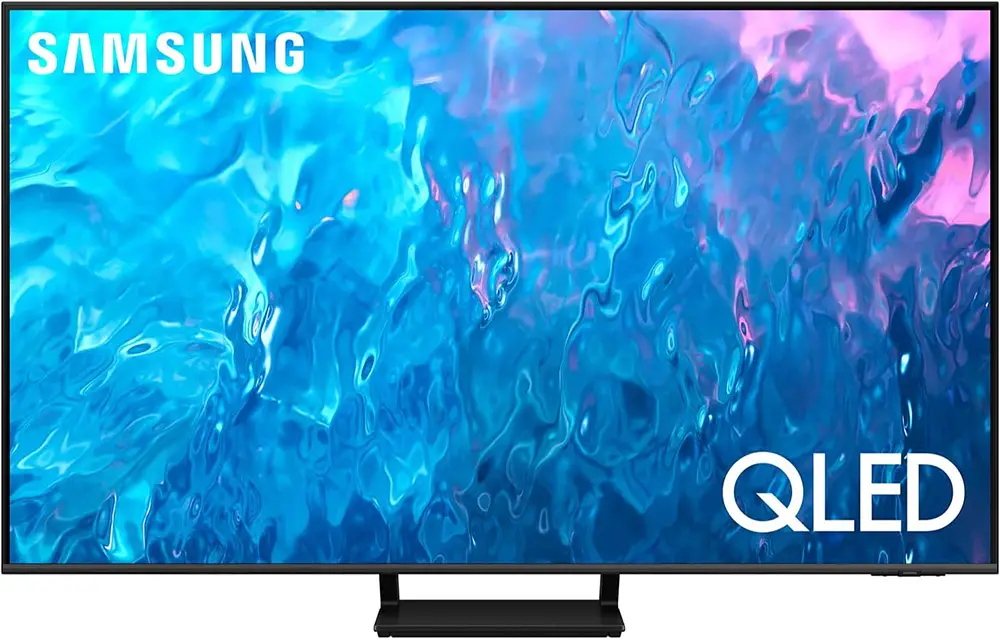
The Q70C may be the replacement the 2022 Q70B but all these units, especially in the mid tier section, do have a lot of similarities between them. So it will be interesting to see if the Q70C comes with any meaningful improvements or Samsung decided to release another rebranded model.
Going through the specs real quick we see that this TV is the last one in Samsung’s lineup that comes with a VA type, 100/120Hz frequency panel. For processing it uses Samsung’s Quantum Processor 4K and for audio the OTS Lite system. It comes with four HDMI 2.1 ports while it uses the latest Tizen 2023.
On paper the only major differences, or upgrades if you like, is that the new Q70C comes with full HDMI 2.1 support and the latest Tizen platform. Are these the only real changes? Let’s put it to the test to find out.
Design
Upon first look the Q70C’s design looks awfully similar to the Q70A. But when you look carefully you will notice that they are definitely different TVs. As there are minor differences in the design and layout of the back side. So this is not just a re-release of an older Samsung model.
Keep in mind that the Q70C is an Edge LED TV, and these tend to look nice with their slim profiles and thin silhouettes.
Measurements
The inclusion of an Edge LED backlight allowed Samsung to use their familiar Airslim design. This is the same one we saw in some of their previous models that come with the same backlight. As such the Q70C measured a very nice 1.10″ (2.8 cm) thickness which will make this one look great if mounted on a wall.
Its black borders remained the same at 0.47″ (1.2 cm) which is excellent for this category.
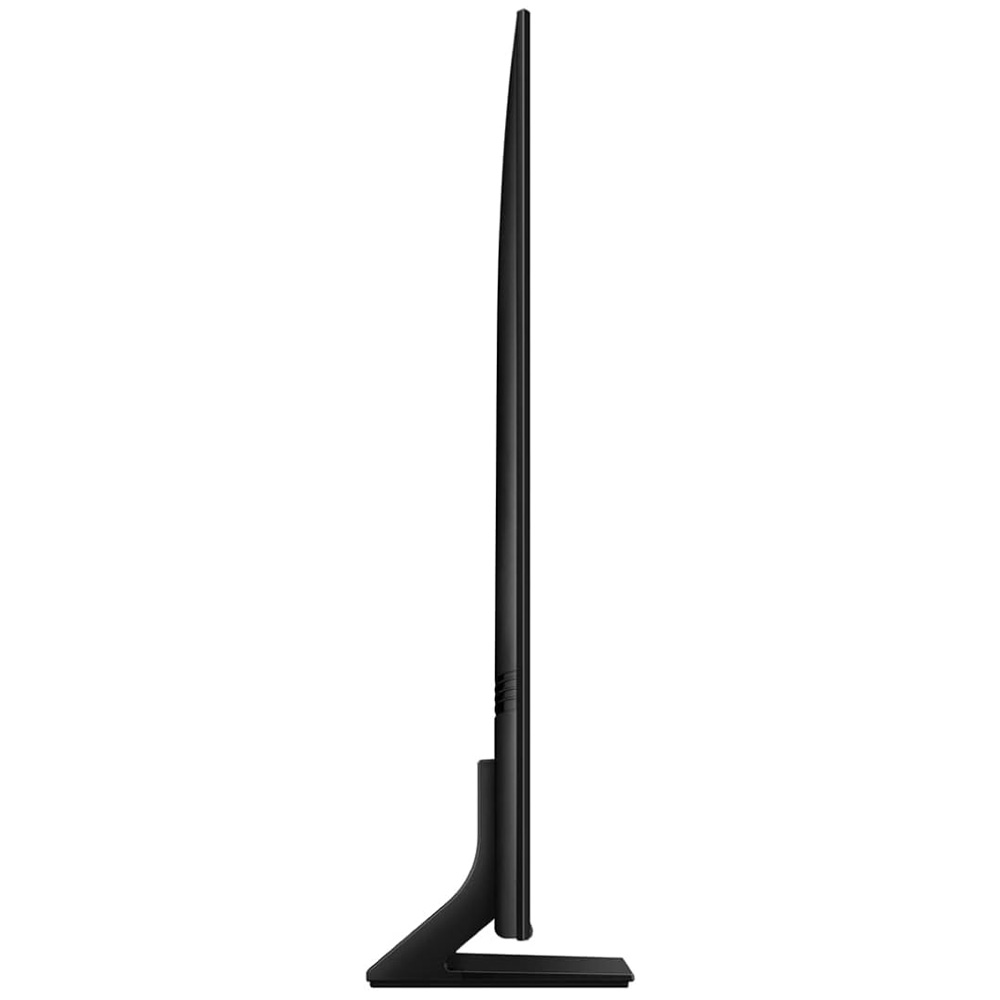
Back Side
Turning the TV around we see many similarities with the Q70A but also minor changes. Samsung still uses a brushed textured plastic as per usual. On the left we get all the connection ports and on the right the power connector.
Just above the stand there are special grooves to help with cable management. And towards the center the VESA holes are the only element visible.
Stand
Similar to the TV itself, the stand is similar to the one used in the 2021 model. But again it is not exactly the same.
The Q70C uses a central stand but with two small legs connecting the panel to the base. Again it is made entirely out of plastic and it does look a bit cheap to be honest. Some wobble was noticeable but this depends on the size of the TV also.
Once again the back of the legs have special grooves so you can keep the cables as invincible as possible.
Lastly there seems to be enough space for a soundbar to place under the panel. But this varies depending on the TV size. And you better measure before buying just to be on the safe side.

Remote
As for the remote, this is exactly the same one as in all 2023 releases. So essentially it’s the same we used in our S95C, QN90C or Q80C reviews. It is very similar to the 2022 remote but there are some minor design changes. The new remote lost one button at the top and it has a slightly different design with more round corners in all sides.
It is still small and uses very few buttons as it relies on the TV’s UI for most of its functions. It comes with a rechargeable battery that can be charged either through a USB-C cable or from its solar equipped back side.
The new remote is every bit as functional and practical as it was last year. To be honest we are not very thrilled by the minor design change but this comes down to personal taste.
Video Quality
Processor technology used
The Q70C is the only new release, excluding the 2023 The Frame, that is using Samsung’s Quantum Processor 4K. This is the same chip we saw in the Q70A and also in the 2022 Q80B and Q70B.
With the arrival of mini LED the new Neo QLEDs are using updated chips. So the Quantum Processor 4K seems to slowly being phased out.
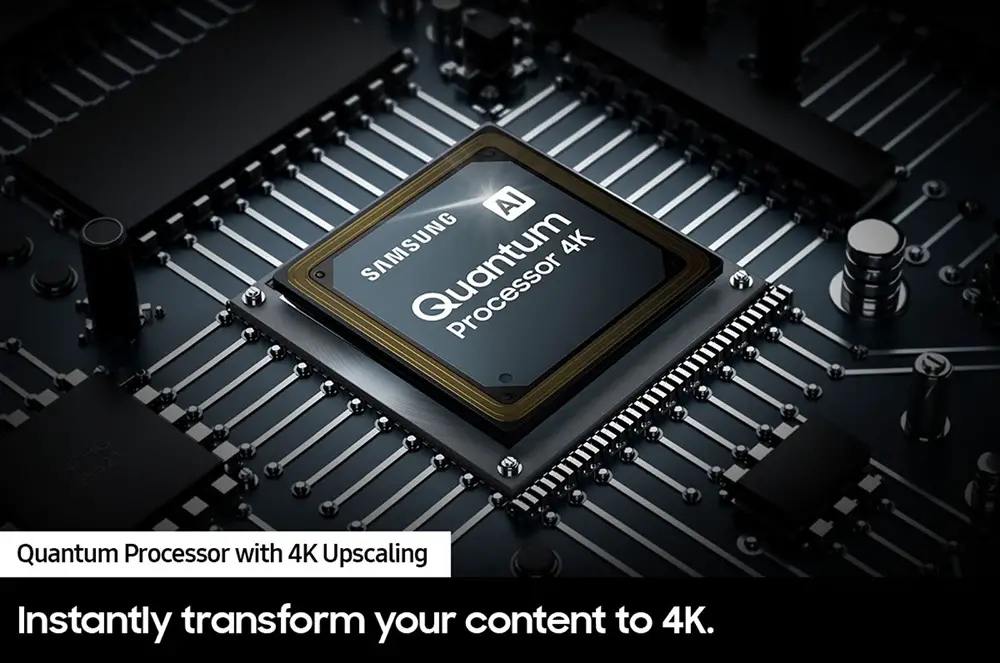
There is no indication if the Quantum Processor 4K we have in 2023 is exactly the same chip we saw last year. But it features the same AI enhanced capabilities as far as it’s image and audio is concerned. These include a specialized AI upscaling engine that is combining complex algorithms and a huge image database in order to classify aspects like textures and edges, and to optimally upscale each specific scene.
Also its Real Depth Enhancer feature automatically separates objects in the content from the background. This creates a 3D like depth in order to make the image even more immersive.
Another feature that finds its way from previous years is Adaptive Picture. This can analyze the light conditions in your room and can calibrate the picture accordingly in order to provide you the best image quality for your specific situation.
Low Quality Processing
We run a few videos in different resolutions ranging from ultra low quality ones, some 480p DVDs, some in 720p and obviously 1080p resolutions. In all our tests the Q70C did ok, considering its category. The TV was capable of upscaling low resolution content without losing a lot of details. Text was not super sharp but it was distinct enough.
With low quality streaming content the TV had a lot of trouble as macro-blocking was very much visible. Obviously you shouldn’t expect any miracles in this category. But to be honest the Q70C disappointed us a bit in this front.

Audio Processing
Once again we find the OTS Lite variant which is typical for many mid to lower tier releases. We will talk more about this in the dedicated audio section below.
Along with it we get various audio features like Adaptive Sound+ and Active Voice Amplifier (AVA).
Lighting technology used
The Q70C, being a low mid-tier TV, comes with an improved Edge LED backlight system. Which Samsung calls a Dual LED backlight.
This is exactly the same system used in the Q60C we saw this year.
Dual LED Explained
Basically a Dual LED backlight is a type of Edge LED backlight. This means that the Q70C has an array of LEDs on the top and bottom of the screen. This type of backlight is obviously far cheaper to incorporate and thus used in lower tier models. But obviously it has its disadvantages compared to the more advanced mini LED or FALD systems.
But while the Q70C is using an Edge lit system, from 2020 Samsung seems to have made some tweaks to it. And these tweaks resulted in this improved system that they call Dual LED. Samsung is calling it like this because it uses two different LED colors. This way it can adjust the color tone according to the image being displayed. Additionally there is no local dimming that could further help with the weaknesses such a system has.

Other than that this type of system comes with the usual advantages and disadvantages. On the one side TVs with such a system tend to be slightly thinner. But on the other side we tend to see strips of light from top to bottom. This mostly happens when a bright object is displayed on a dark background.
If you want a better backlight system then you will certainly have to go higher in price. And that is the Q80C which is the only Samsung TV in 2023 that still features a FALD system. Or considerably higher in the performance ladder to the QN85C which is the cheapest mini LED TV you can get.
Number of Dimming Zones
As the TV is using an Edge LED system with no local dimming there are no LED zones behind the panel to light individually.
Blooming & Zones Transitioning
And this means that there is no zone transitioning. The TV cannot light specific areas of the screen when there is a highlight visible.
No local dimming means that there is no obvious blooming that most FALD and mini LED systems are plagued with. But on the other hand, in similar scenes, the whole screen feels washed out and less than ideal.
This happens because the TV has to rise the brightness of the whole panel when a bright object is visible. And this results in the whole screen looking over-brightened.

Brightness / Contrast
Next we will be looking at the brightness of the unit. In terms of settings we used the usual as we do in most Samsung models. We used the Movie mode and Warm 2 color tone. This was for SDR content as with HDR we would suggest you use the Filmmaker mode better.
SDR and HDR Measurements
First test here is the SDR brightness over a 10% window and the number we got was 460 nits which is good enough. With such brightness the Q70C is capable enough of combating glare in a bright room.
We then switched to HDR content and in our HDR brightness over a 10% window test we measured 430 nits. This is mediocre at best and while HDR does have some pop to it, it surely is not as impressive as it can be.
Automatic Brightness Limiter (ABL)
As with most TVs nowadays the Q70C comes with an Automatic Brightness Limiter (ABL). This system lowers the overall brightness of the screen when large parts of it become very bright for a long period of time. This may not be very obvious when watching a movie for example. But it can be noticed more with bright static images, or if you use the TV as a computer monitor.

The Q70C managed to maintain its brightness no matter how long a bright image displayed on screen. We didn’t notice any noteworthy changes in the brightness either it was SDR or HDR content. And this is a behavior we have observed in many TVs with low brightness output.
In these cases the ABL is not needed as the brightness output is not high enough for the ABL to kick in. And this is the reason why we do not see changes at all compared to TVs with very high brightness limits.
Essentially this is the same behavior we noticed in our Samsung Q60C review.
Last Year Comparison
Since we didn’t test last year’s Q70B we can only compare it to the 2021 Q70A. And from the numbers we got it seems that the new Q70C is more of a downgrade. The Q70A was noticeable brighter in our tests.
EOTF Tracking
Brightness levels were really close to the EOTF reference values during the entire range. Only the near black levels were above the target values but the rest of the chart was almost spot on.
Reaching its limit the TV has a sharp roll-off which results in some clipping and loss of detail.

Contrast Performance
In terms of contrast the Q70C comes with a VA panel. Usually VA panels tend to have good contrast ratios and this TV is no different showcasing pretty deep blacks.
Unfortunately, as we mentioned above, there is no local dimming here. Usually having this helps with contrast even further but this is not the problem with the Q70C. The problem is that without it when there is a bright highlight the whole image will look washed out.
This happens because the TV cannot handle brightness in specific parts of the screen. Instead it has to increase the brightness on the entire panel, which creates this washed out look. All TVs without a local dimming feature behave the same.
It is similar to many TVs we tested lately like the Q60C, Samsung CU8000 and CU7000.
Viewing angles
The Q70C comes with a VA panel and these in general don’t have very good viewing angles. In essence the TV performs similar to most other VA panel equipped TVs that don’t use some extra layer to improve angles.
Unfortunately the QLED series, being a low mid-tier series now, doesn’t get this layer anymore. As a result the TV has a very narrow field where it can keep it’s image integrity at acceptable levels. From what we saw 25 degrees with an absolute maximum of 30 degrees is the most this TV can do. Anything more and image colors, black levels and brightness degrade a lot.
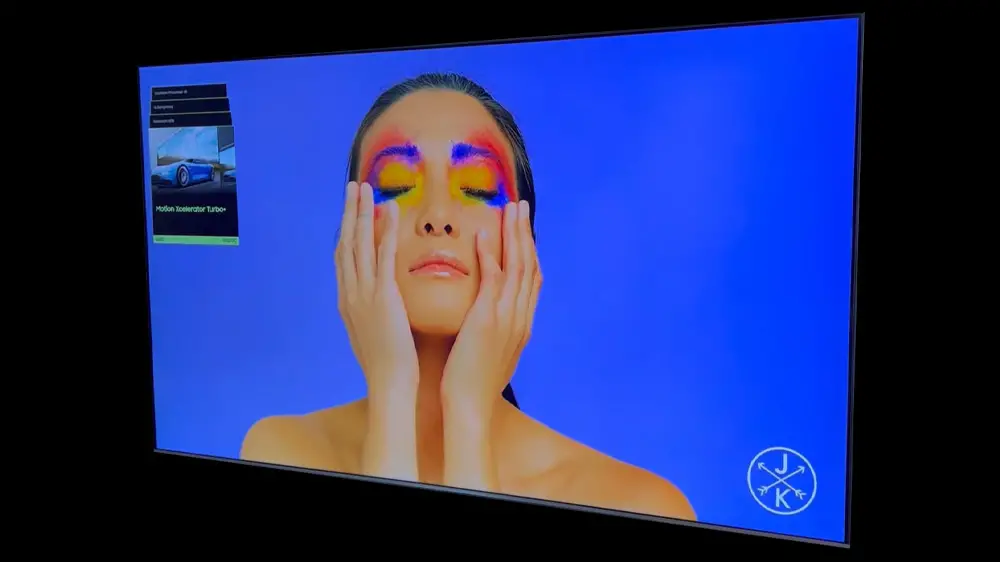
If you have a sweet spot from where you will be watching then this is not a big problem but if you plan to use this one in a family room then we would strongly suggest you try it out first before purchase.
The TV performed similar to many other VA TVs in the same category. So no real surprises here.
HDR support
HDR support is another area where things haven’t changed much. As it seems that most brands stick to their guns without any changing in sight. As such we get the most basic HDR10 that is required for 4K UHD playback. There is also HLG that is used mainly for broadcasting. And lastly the newer HDR10+ which is the most advanced HDR protocol. This uses dynamic metadata in order to provide the best image quality on a frame by frame basis, similar to what Dolby Vision is doing.
In the Q70C we also find HDR10+ Adaptive and HDR10+ Gaming. HDR10+ Adaptive uses its AI engine to analyze the viewing environment. This includes the lighting, brightness and even reflections using the sensors equipped on the TV.
The results are then incorporated into the dynamic metadata. After going through four further steps, the brightness and contrast of a scene are optimized. This way you can view HDR10+ movies and television programs in various environments at home.

Keep in mind that like many new Samsung TVs the Q70C comes with an HDR Tone Mapping setting. You can set this to either Static or Active with Static being more accurate. Active will increase highlight intensity but makes the image less natural.
Unfortunately, Samsung still refuses to allow Dolby Vision in their TVs and stay firm behind their own HDR10+. Unfortunately this is not going to change any time soon. So if you really want Dolby Vision you will have to look for another brand.
Color coverage
Being a QLED, the Q70C is using a special Quantum Dot layer in order to display 100% of the DCI-P3 color space. But naturally these claims are never true. So let’s see how close the Q70C can get to that.
From our measurements the TV can reach about 91% coverage of the DCI-P3 color space which is really good. On the wider REC.2020 color space we got a coverage of 67%. Which again is very good and around what we were expecting to get.
From these numbers it seems that the Q70C seems to perform almost the same as the Q70A. Nothing really changed here.
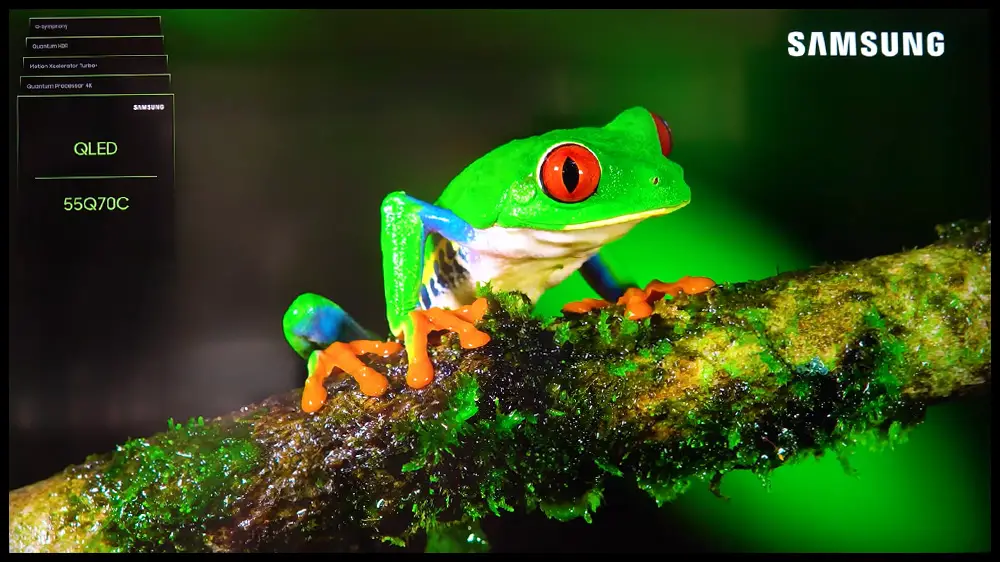
DeltaE Errors
Before calibration the TV had bad color accuracy. White balance, color temperature and gamma were way off their target values while many colors had values above the DeltaE limit of three.
After calibration we were able to correct many of the above errors. Color temperature was close to its target point but still not perfect. White balance was much better while we were able to bring gamma to almost perfect levels. As for colors most of them stayed below the DeltaE limit of three. But some red shades were still above the preferred threshold.
From all the above we can definitely say that the Q70C needs you to invest some time on it. If you really want it to be accurate enough then it surely needs some good calibration. Its out of the box performance was disappointing and do not show what this TV can really do.
Color Gradients
Color gradients were so and so as we noticed banding in almost all color shades. It was not so bad to the point of being distracting but it was all over the place. With real world content it may not be so much noticeable. But this really depends on the scene and the colors present.
There is also a Noise Reduction function in case you do see it. But if you enable it some detail is lost and in general we didn’t like this feature much.

Panel Uniformity
Panel uniformity was not very good in the Q70C. Gray uniformity revealed very notable differences between the corners and the center of the screen. This is an effect called vignetting. We also did notice some dirty screen effect. On the other hand with blacks and darker colors the screen revealed some backlight bleeding.
Motion performance
We move on to our motion performance tests. The Q70C comes with a 120Hz panel along with a backlight dimming frequency of 960Hz. As we mentioned above the Q70C is the most affordable Samsung TV this year to support 120Hz. This means that if 120Hz gaming is a must to you this is the most affordable TV you can get from them.
When using the TV without any motion interpolation we did notice some blur during fast action scenes but it was not so obvious or bothering. But overall the Q70C had some very solid results here.
Motion Interpolation
Motion interpolation could not be missing and is named Motion Xcelerator Turbo+. The Q70C was capable of removing both motion blur and stutter from content but as usual artifacts would become visible in some cases.
In scenes where the camera would make fast movements the TV could not keep up. This resulted in some visible artifacts, and depending the content these would increase as the camera movements would become faster. We also noticed some image duplication which was very obvious in certain instances.

Another area where the Q70C seems to perform similar to other Samsung TVs is with stutter. The TV was practically stutter-free in 60 fps content. With lower, 24 fps content, we did notice some stutter but it was not so much to be bothering.
Motion Interpolation is enabled in the same way as with all other Samsung models. You will find it in the Picture Clarity settings, in the menu, and by adjusting the two sliders for blur or judder.
Keep in mind that very high values in the sliders and the “Soap Opera Effect” will appear. So if you want to improve motion keep minimal values in these two sliders. A value of 1 or 2 can smooth motion enough without affecting the quality much.
Black Frame Insertion (BFI)
Black Frame Insertion (BFI) is also available and can be enabled in the menu with the LED Clear Motion option. BFI is a technique that inserts a black frame in between two individual frames in order to smooth out motion.
BFI in the Q70C is not so good, which is not all that surprising for a TV in this price. It does smooth motion but not without some undesirable side effects.
Firstly with it enabled we noticed some very obvious image duplication. Another downside is that brightness takes a visible hit. Which is detrimental with such a low performance TV. And lastly due to the lower frequency used, which is 60Hz, some flickering may become noticeable.

Overall Motion Impressions
The TV behaved very close to other TVs on the same category. It has its ups and downs both with and without any of the motion interpolation features available. The good thing is that both motion interpolation and BFI are available. So we suggest you try out them all and decide for yourself which one gives you the least undesirable effects.
Input lag Measurements
Input lag testing coming next.
According to our measurements the TV displayed an average of 11.5ms input lag in both 1080p and 4K resolutions at 60Hz. Switching to 120Hz input lag fell to 6.5ms, in both 1080p and 4K resolutions. The Q70C cannot do 144Hz like some other TVs this year. So 120Hz is the best you can get.
We took both measurements after we obviously switched to Game mode. If you switch to another picture mode the input lag will go up to 67ms. Which is still respectable and usable for slow paced offline games.
The Q70C seems to have improved slightly compared to the Q70A. The difference is small but we got better numbers in all our measurements.

Other Gaming Features
We should also not forget to mention that the TV supports Auto Low Latency Mode (ALLM). And both the PS5 and Xbox consoles support this feature, so the TV will switch to Game mode automatically.
HGiG Mode is not missing either. This is HDR Gaming Interest Group’s technology that ensures you enjoy HDR games the way that their creators and developers intended.
One feature that we got in 2022 through a firmware update was the Samsung Game Hub. Well, this year it is available from the start in many of the new models, including the Q70C. With it you can use various online gaming services, including the Samsung-exclusive Xbox app. But as always the kind of content you will find in the Hub depends on the region you are.
VRR Support
The Q70C makes sure to include all VRR support there is. As such we find HDMI Forum VRR, AMD FreeSync Premium Pro and NVIDIA G-Sync. And you can handle all of them in the new Game Bar 3.0.
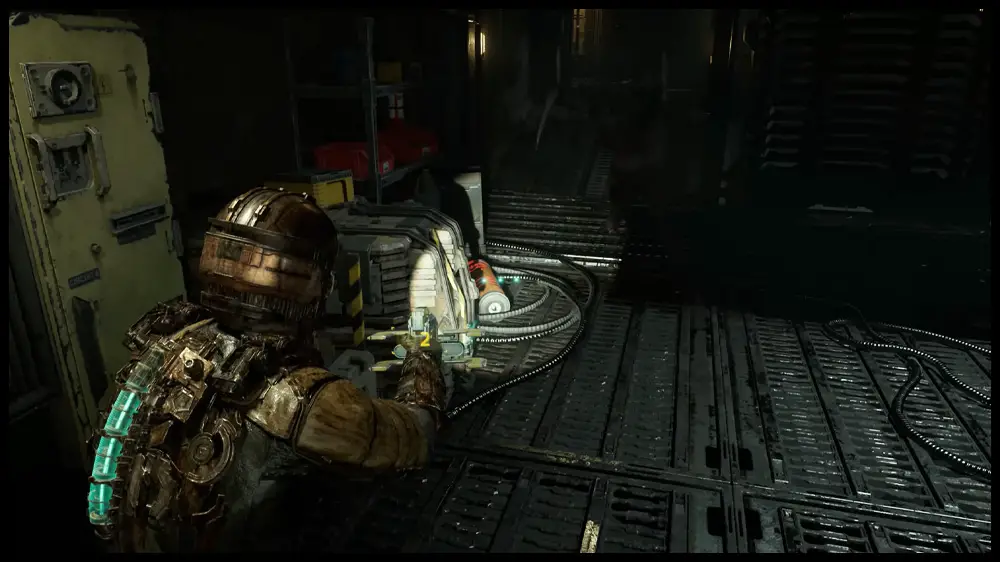
Trying Out a Few Games
For testing the TV’s gaming capabilities we tried a couple of games. The first one was F1 2022 which has a 120Hz mode while the second one was Dead Space which goes only up to 60Hz.
The Q70C did very good with both of them. With Game mode enabled the kind of performance we got was great for a mid tier TV like this. All our commands registered on screen extremely fast. And we didn’t notice any delays or slow response times that could affect our experience.
This TV can definitely be used for gaming even outside Game mode. We did try a couple of single player games like this to get a feeling of the higher input lag. And although it does need some getting used to it, after a few minutes you can surely adapt to it.
Overall Image Quality Impressions
Although we cannot directly compare the Q70C with the 2022 Q70B, compared to the 2021 Q70A that we did test we see some interesting results.
The new Q70C is obviously dimmer, it has lower out of the box accuracy and has lower contrast. On the other hand it seems that its gaming abilities got better. Its input lag was further improved and has four HDMI 2.1 ports instead of one.
In most other areas both of them were very close to each other.

Audio Quality
As most brands, Samsung developed their own audio system to use in many of their top and middle tier models. It is called Object Tracking Sound and as of 2021 there are four variants of this system depending how capable it is. We have the OTS Pro, OTS+, OTS and OTS Lite.
The Q70C got the Object Tracking Sound Lite (OTS Lite) variant, which basically is the same system we find in many low and mid tier releases.
Audio System – Channels & Power Rating
The Object Tracking Sound Lite (OTS Lite) in the Q70C goes for a 2.0 channels configuration with 20 watts of power output.
Audio Formats Support
The TV supports Dolby Audio but there is no native Dolby Atmos. At least you can pass-through Dolby Atmos through the included eARC to some Dolby Atmos soundbar or dedicated sound system.
Once again there is no DTS support. As such, the TV cannot decode or pass-through DTS audio signals to another device. Samsung made that decision some years ago and seems to be definite.
If you really want DTS then Sony and LG are the only ones that support it. LG brought DTS support back this year after being absent in the previous releases. Hopefully LG’s decision to bring DTS back will force Samsung to do the same in the future.
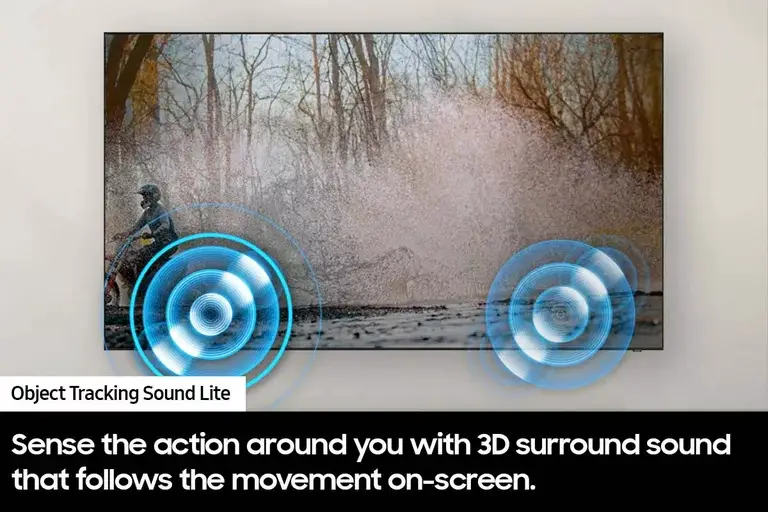
Audio Features
Samsung is adding a lot of audio features in their models, so let’s take a look at some of them.
First we find Adaptive Sound+ with which the TV analyzes the content and for each scene can identify and render the best sound type. This whole process starts by separating and classifying audio input signals. After it pulls out its key characteristics, it renders them to best suit the scene.
We also get Active Voice Amplifier (AVA). By using AVA the TV can detect environmental noise and enhance the voice output of the content you watch for a more pleasant viewing experience.
And obviously with a Samsung TV we could not miss Q-Symphony. This is a feature that you can use to combine the TVs audio system with an appropriate soundbar that supports it.
This year Samsung released Q-Symphony 3.0 and with it the audio can sync and output from both devices for an even more immersive audio experience. Samsung released a whole lineup of soundbars that support this feature in case you are thinking of getting one.
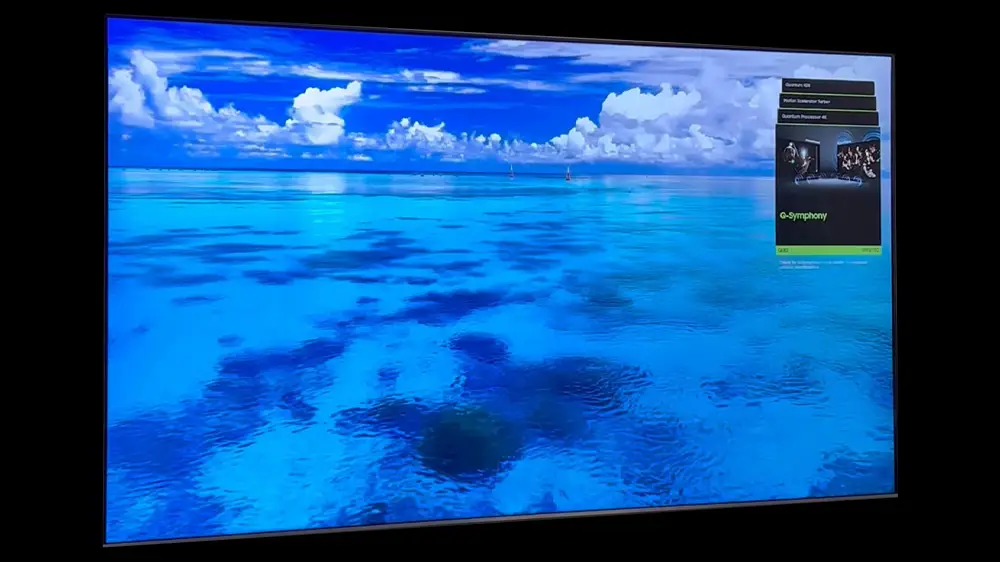
Overall Audio Performance Impressions
Unfortunately the built-in audio system is only good enough for casual use. For news broadcasting, sports, casual TV series and other similar content it will suffice. But if you really want to get cinematic sound you will be disappointed. For that you will definitely need a full surround system or at least a good performing Dolby Atmos soundbar.
The TV can get loud and dialog was distinct enough. But the TV lacks in depth, sound extension and low end prowess. As such most action films will sound flat, very confined and surely uninspiring.
Ports and Connectivity
Samsung is using the exact same layout in many of their TVs for some years now. And the Q70C is no different.
Starting from the top we find two USB ports, a single digital optical output, four HDMI ports, an Ethernet port for wired connection to your local network, an Ex-Link port and the usual antenna/cable connector.
HDMI Specifications
From 2022 onwards Samsung updated the HDMI ports in order for all of them to support the full 48Gbps bandwidth. And this continues into 2023 with the Q70C using four, fully capable HDMI 2.1 ports.
These support all new and old features including 4K@120, ARC, eARC, ALLM, VRR, G-Sync, FreeSync Premium Pro, HFR and HDMI-CEC.
Connectivity Observations
And while we could not be happier with the four HDMI 2.1 ports, the inclusion of a 100Mbps Ethernet port is inexcusable in 2023, even if we are talking about a mid-tier release as the Q70C is. We cannot understand why TV manufacturers still insist on not including Gigabit adapters.
Streaming requirements and internet connections have greatly advanced the last few years. This made the 100Mbps limit obsolete a while back. And while most TVs update their WiFi capabilities (some models support WiFi6 this year) the Ethernet adapters are still the same.
Wireless Capabilities
When it comes to its wireless capabilities the Samsung Q70C supports WiFi5 (802.11ac) along with Bluetooth 5.2 which is the same across all Samsung TVs in 2023.
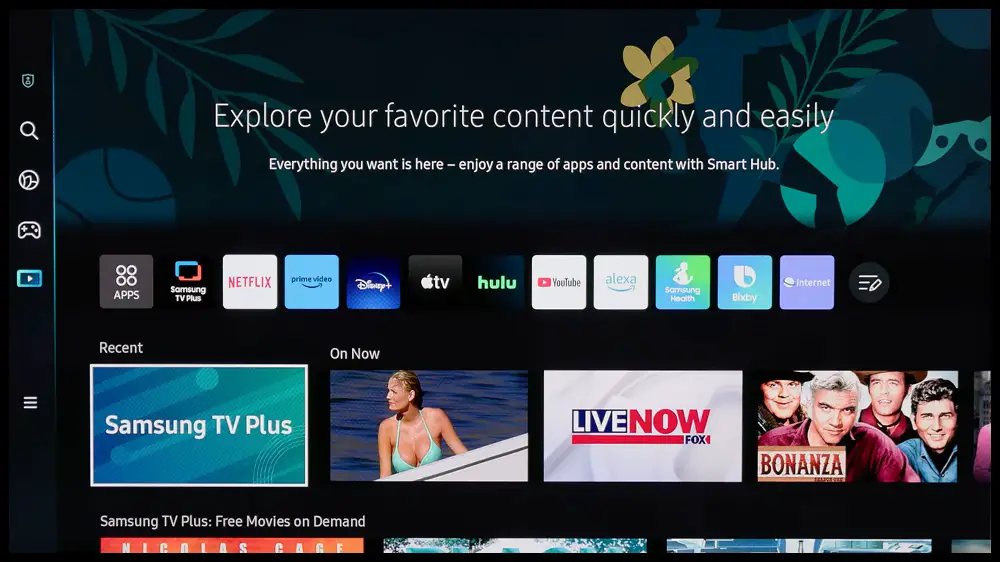
OS, Apps and Features
Samsung updated their OS to the latest 2023 version but this is only a minor upgrade compared to the 2022 version. Almost everything is still the same and this year there are small improvements and additions.
Tizen 2023
Being a Samsung TV means that for its OS we find the usual Tizen platform in its 2023 edition. The new Tizen occupies the whole screen instead of being a tile based row at the bottom of the screen, exactly as Google TV and webOS are lately.
It seems that smart TV platforms opt for a more personalized experience and as such the new OS tries to provide you with options that are tailored for your viewing habits. As such you will see personalized ads, recommendations for streaming services and broadcasting channels and even shopping suggestions.
If you have used Tizen before 2022, the new version may feel a bit chaotic at first. This was the same with Google TV and webOS when they changed into a full screen UI and certainly you will need to spend some time with it to get your bearings. But once you get the hung of it, it is easier to navigate than it may seem.
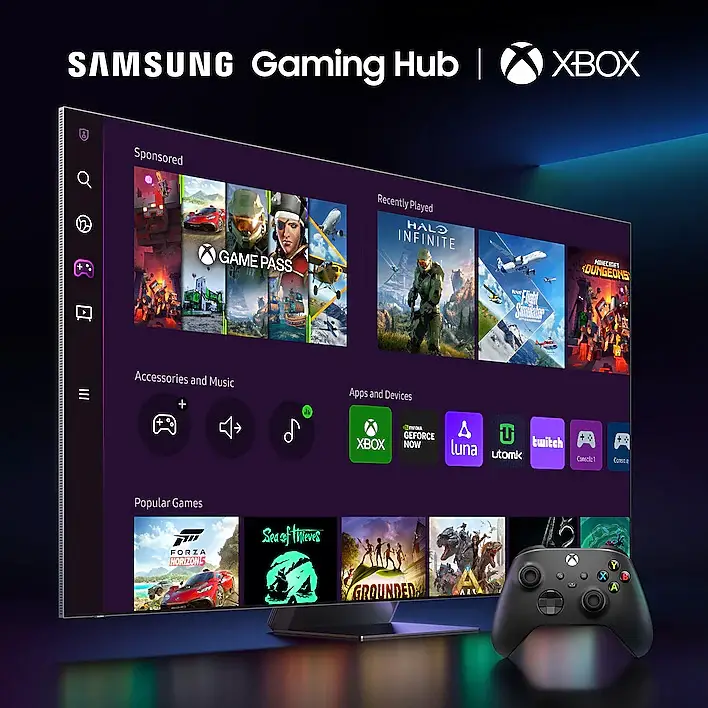
Samsung Smart TV Hub
The new Samsung Smart TV Hub includes different sections and it allows you to navigate easily through all of them. At the left of the screen there is a single column with a few central selections while the rest of the screen use rows with streaming services, apps and other functions and features available.
The new Tizen is not all that different really. Obviously the layout is tailored to Samsung’s needs but in essence it offers the same thing.
The Tizen 2023 in the Q70C was responsive enough but there were a few moments were it would slow down during app changing. Overall our experience was smooth enough but we did notice a few hiccups compared to the smooth experience we got in some higher tier models.
Game Bar 3.0
Let’s go over some of the features we find this year. These are all the same features we saw in many 2023 Samsung TVs, so no real changes here. And the first we will talk about is the Game Bar.

In 2023 this feature is now in its 3.0 version. This is an on-screen menu that lets you make real-time adjustments to screen ratio, input lag check, FPS, HDR, wireless headset settings and more. This can be a really handy feature to gamers as you don’t have to mess with menus every time you want to check on a specific setting. With this quick feature you have everything in front of you with the click of a button.
The new Game Bar 3.0 has a couple 2023 features that were not available before. This is MiniMap sharing and Virtual Aim Point for gaming. And, as we mentioned above, Samsung TVs remain the only ones that include Xbox’s Game Pass.
Streaming Capabilities
When it comes to content the Tizen platform is famous for it’s enormous support from developers. The Q70C offers practically all known services and platforms you can think of. Netflix, Apple TV, Disney Plus, Youtube, Amazon, Hulu, Rakuten, Demand 5 and BBC iPlayer are just a few of the big names available.
There is also Samsung TV plus which offers hundreds of subscription-free channels to choose from. Many of these services can playback in both 4K with HDR like Netflix and Amazon but this really depends on each app and not on the TV itself.
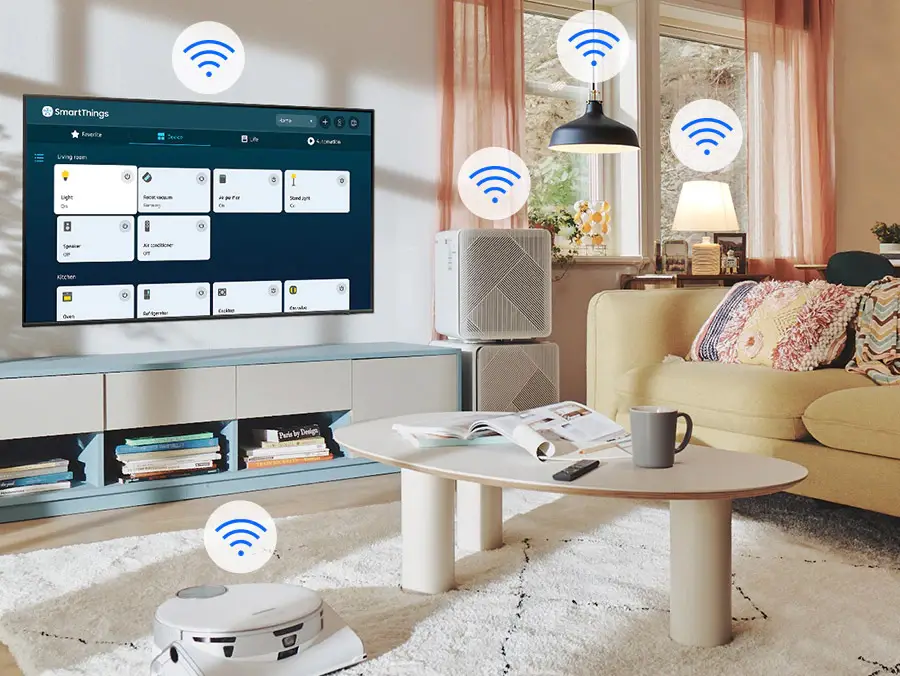
SmartThings Integration
With a Samsung TV SmartThings integration is a must. With it you can make your TV the central hub of all your smart houses devices. These can be lights, electronic locks, alarms, vacuum robots, thermostats and everything that supports the SmartThings platform.
For 2023 Samsung added Matter and Thread integration meaning you can control such devices from a single app instead of multiple ones and there is no need for an additional dongle as it is built-in the TV itself.
Voice Control
Voice control is another standard feature nowadays. It seems that Samsung is really trying to market their own Bixby service. But even if you are not very fond of that there is Amazon’s Alexa or Google Assistant to choose from. Only keep in mind that for Google Assistant you will need an external device for it to work. Amazon Alexa on the other hand is built-in and you can issue your commands through the remote’s microphone.
Additionally, if you are an Apple guy then don’t get disappointed as there is Airplay 2 support. And you can even use Siri through it for your voice commands. Unfortunately while Airplay is available HomeKit is not, something that hasn’t really changed lately for Samsung.
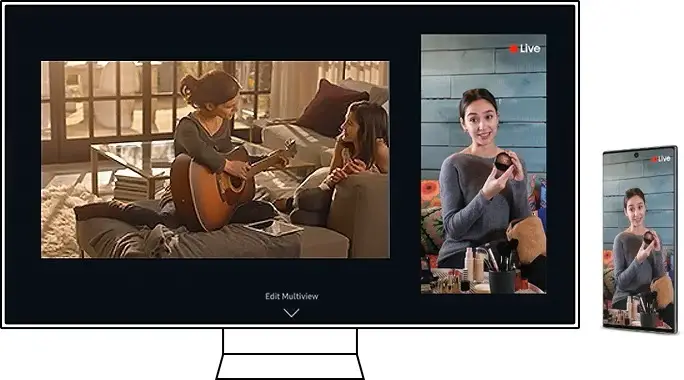
Multi-View & Tap-View
Two more features that we find for one more year is Multi View and Tap View.
With Multi-View you can display multiple windows on screen at the same time. These windows can be different with one showing your favorite broadcasting channel, while the other display your smartphone’s screen.
And then there is Tap View. With it you can mirror your phone on your TV with just a tap to continue enjoying movies, music, and apps on the bigger screen within seconds. Nothing major, but anything that can save even a few seconds of your time can be valuable.
Ambient Mode+
Another returning feature is Ambient Mode+. This is a slightly more enhanced version of the Ambient Mode we get in many Samsung models for the last few years. With the plus version except from the ability to display various images on the TV, when not in use, it can also project various information including weather updates, news headlines, photos and music.
Samsung Health
Samsung Health is another standard feature by now. The last few years, with the coronavirus pandemic, many people were staying indoors so Samsung thought that exercise at home would be on the rise. So many of their TVs came with Samsung’s program in order to stay in shape. It seems that Samsung liked it so they decided to keep it.

Compared to other TVs
As we mentioned above we missed last year’s model. So the most direct comparison we can do is with the 2021 Samsung Q70A. And from everything we saw each one has its own strengths. For content viewing the Q70A is definitely better. On the other hand the Q70C is better with gaming as it has lower input lag and comes with four HDMI 2.1 ports.
Unfortunately from LG there is no TV from this year or even 2022 that we have tested in the same price range so we cannot really compare it with any of their releases so far.
A 2023 model that we can compare it with is the 2023 TCL Q7 that we reviewed recently. The TCL comes at a slightly lower price but overall it is the better TV between the two. In terms of picture quality it is far better than the Q70C. The only areas where the Q70C is better is with low resolution content up-scaling, input lag and that it comes with four HDMI 2.1 ports.
From Sony we can compare it to the 2022 X80K which is priced almost the same. Again here we do not have a clear winner. The Q70C is brighter, has better color coverage and better gaming features. But the Sony has better viewing angles, better processing and supports Dolby Vision. So it really depends what your needs are.
Lastly, we can compare the Q70C to the 2022 Hisense U8H. The Hisense is far better in almost all areas and there is no real comparison between the two models. The only area where the Samsung is better is with gaming. As it features lower input lag compared to the U8H and has four HDMI 2.1 ports.

Final Thoughts
It seems that there are not many surprises for us in the mid tier category from Samsung this year. The new Q70C retains a lot of the characteristics we saw in some of its predecessors with minor changes, for better of for worse.
The Q70C’s strongest points are its good SDR performance, solid motion and strong gaming features. Its input lag is extremely low, it comes with four HDMI 2.1 ports and its enhanced Game Bar offers a totally new gaming experience. Also the latest Tizen platform will give you everything a smart TV should have in this day and age.
On the other hand HDR performance was average with brightness not being as high as we would like. Out of the box performance was not very good either. Viewing angles were mediocre, something not ideal for a family TV. And in general the Edge LED system without local dimming does limit the TV’s capabilities.
Overall the Samsung Q70C is a decent mid tier release. It is the most affordable 120Hz TV Samsung has this year so it will find its audience among the budget conscious gamers. And not without reason. The TV has respectable performance for mixed use but certain weaknesses do not allow it to be the best value for money choice in this category.

For more reviews you can check our dedicated 4K LED LCD TV reviews list or even look at our Product Reviews Table where you can find the brand and specific product you are looking for.
Cheapest Places to Buy :
*We are a reader-supported website. When you buy through links on our site, we may earn a small affiliate commission at no extra cost to you. Home Media Entertainment does not accept money for reviews.*
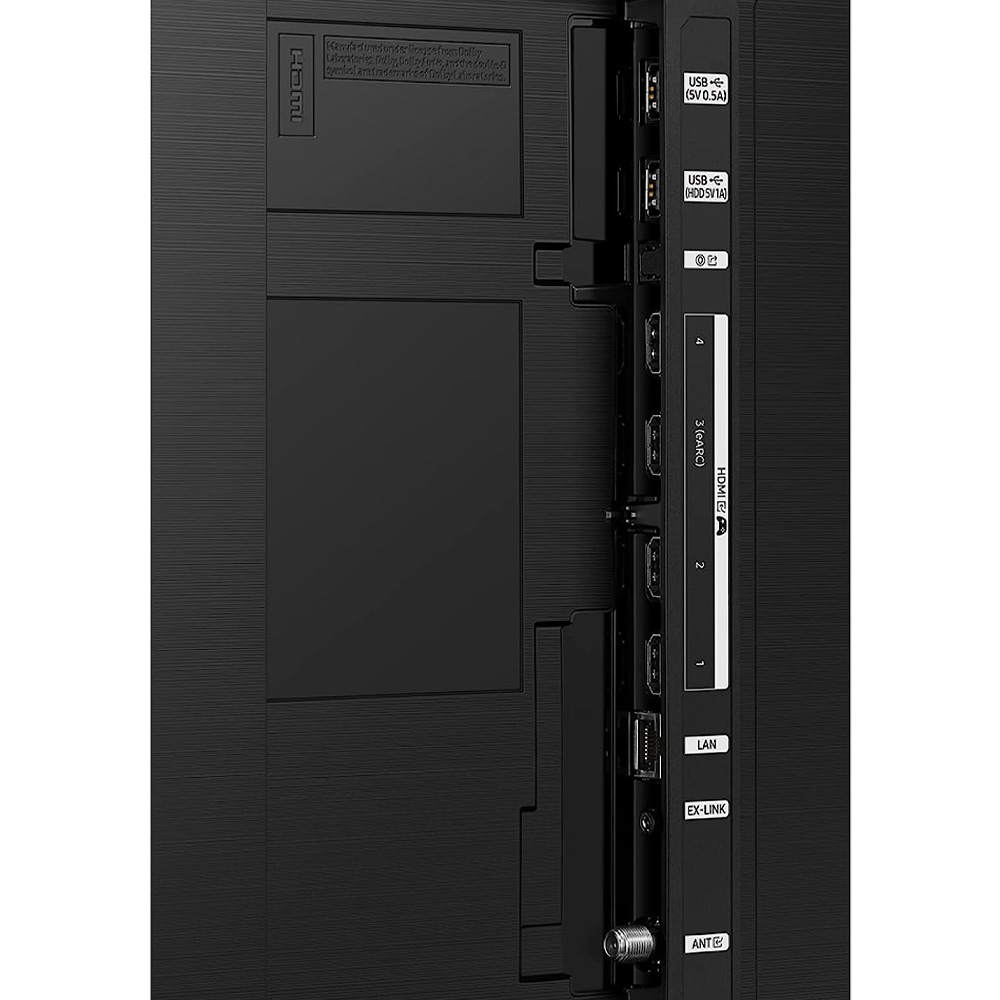
Great review on the Samsung Q70C. It’s nice to see you delving into the detailed measurements. For me personally brightness, contrast, and color coverage are some of the most important aspects of the TV.
What I wanted to ask is how does the Q70C compare to other mid-tier TVs in terms of motion performance, especially for fast-paced content like gaming or action movies?
Hello. Because there are many new models in the mid tier section is there any particular ones you would like to compare it with?
Very thorough review on the Q70C. I have not bought a new television for a number of years now. We are still running our TV with a Roku box to make it a smart TV. So I am really considering its time for a change. I don’t need anything ultra expensive. And I think the Q70C strikes a good balance between price and features.
I like how you also compare the Q70C with other similarly priced models. This has given me food for thought. As is always the case, you are looking for the best machine for the money that you have, which ticks the most boxes, features-wise.
Thanks, Simon
You are welcome Simon. If you need any further assistance making up your mind let me know.